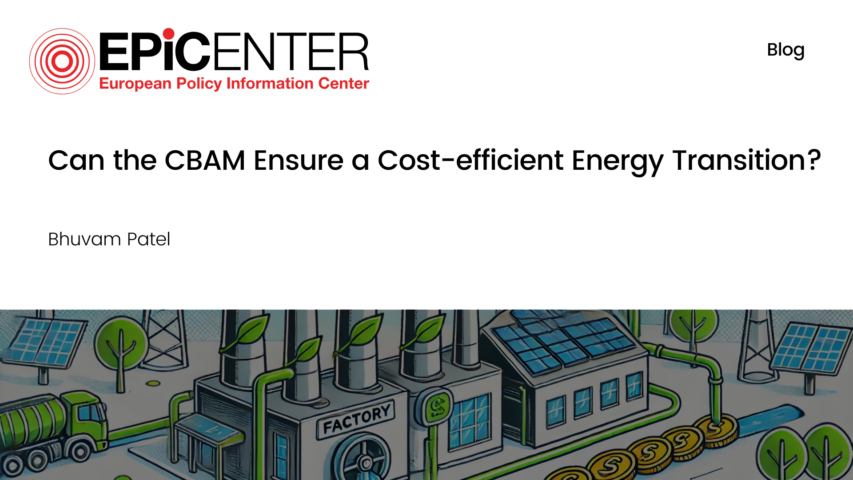Can the CBAM Ensure a Cost-efficient Energy Transition?

Can the CBAM Ensure a Cost-efficient Energy Transition?
Bhuvam Patel // 16 November 2021
The Carbon Borders Adjustment Mechanism (CBAM) is one of the key regulations to compliment the EU’s existing ETS scheme in tackling carbon leakages. As a part of the European Green Deal, the CBAM aims to tackle the issue of carbon leakage by setting border taxes on imports outside the EU. While the CBAM aims to include all industries in the future, the commission has commenced the regulation through a sectoral approach.
With renewable projects becoming more popular in the EU, the European Commission must address issues within the current version of the CBAM which will make the transition more expensive. The current CBAM, while being a more radical change towards 2050 emission goals, is not suitable to facilitate the EU’s energy transition away from emission-heavy sources.
Issues of a sectoral approach
The choice of covered sectors – namely: steel, aluminium, electricity, cement, iron, and fertilisers – displays possible regulatory discrimination within the mechanism. Each sector is considered vital for the development of renewables in Europe as they play important roles in assembling wind turbines and solar panel systems. The CBAM aims to tax these sectors in the short term and aims to expand it into others by 2026. Hence countries like China with lower labour costs and lower product costs will also have to pay carbon border tax when shipping products to the EU.
While the CBAM is a driver for competition within the EU, it creates further barriers to entry for international trade. While there will be fair competition within the EU for local manufacturers who gain comparative advantage, it could also disincentivise non-EU exporters from selling goods at lower costs to the EU. This would also increase prices for renewable infrastructure that is reliant on imports of some carbon intensive goods in the above-mentioned sectors.
Worries for the solar sector
Taking an example from the solar sector, a few key concerns raised are the potential repercussions for solar panel manufacturers in the EU who rely heavily on non-EU suppliers. This is due to demands not being met by current EU production, the CBAM could prove to make the transition and promotion of solar energy a slower and costlier task. Furthermore, another issue within the solar sector seems to be the lack of compensation by CBAM to import-heavy EU suppliers who are already paying emission taxes. These companies rely on their exports but would be subject to stricter financial regulations to move goods into the EU at competitive prices. Solar power agencies are more likely to be dependent on imports but may also start transferring increased costs onto consumers, workers and shareholders as a result of higher costs of procuring materials.
Cross-border liabilities
Another issue of contention would be the sharing of costs and production for renewable projects between EU and Non-EU countries. The CBAM has yet to specify how its functionality would impact projects that are shared by such countries. The liability of cross-border projects would likely be based on the investments the projects rely on and where the consumers will be based. Non-EU Investments into such projects could be curtailed if there are non-EU exporters with stakes in proposed projects who are slapped with higher costs of entry. This would also include transport and freight passing through one or more EU member states to reach the location for such projects.
The CBAM EC trialogues on adopting the proposal for regulation ends on the 18th of November. Hence, a lot of the issues surrounding the CBAM’s efficacy still remain to be discussed. The CBAM’s potential to be counter-productive to the Green Deal’s renewable promises still needs to be tackled within the realm of the existing trajectory of consultations. Amendments could include looking into opening the markets for renewable industries to be exempt from some aspects of the CBAM to keep costs low, however this would mean more complications to an already complex regulation.
A more systemic solution for the EC would be to revamp the tax mechanism itself. Taking the examples of Scandinavian and Swiss carbon taxation the current CBAM could also adopt a flexible system with CBAM related payments that would be elastic to emissions (rising if emissions were higher across the EU). This could ensure fair global competition as well as help the EU come closer to its 2050 goals.
EPICENTER publications and contributions from our member think tanks are designed to promote the discussion of economic issues and the role of markets in solving economic and social problems. As with all EPICENTER publications, the views expressed here are those of the author and not EPICENTER or its member think tanks (which have no corporate view).



